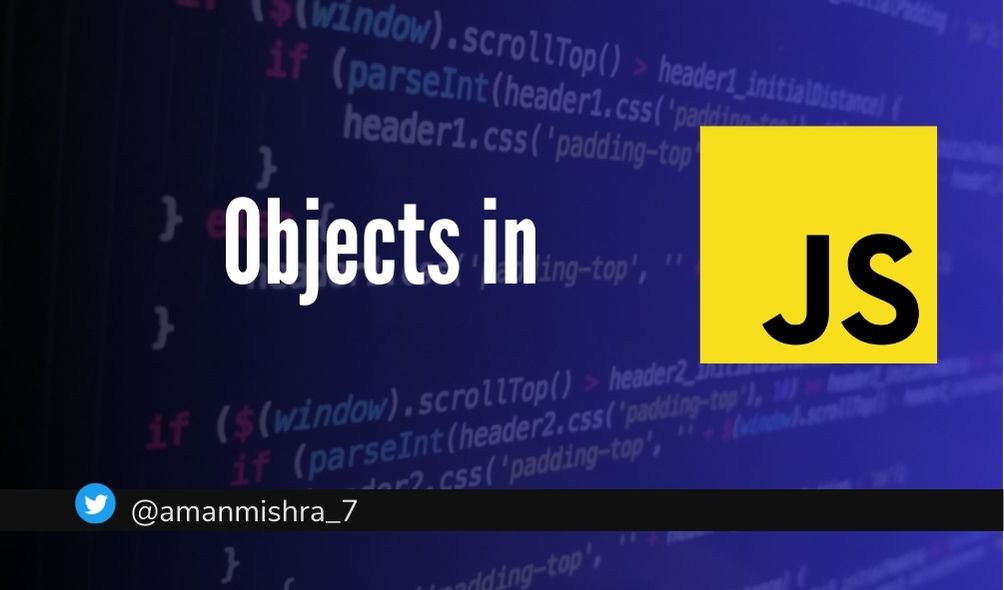Objects in JavaScript
 Aman Mishra
Aman Mishra
Introduction:
JavaScript, the versatile programming language, offers a rich set of tools and features to empower developers in building dynamic and interactive web applications. At the heart of JavaScript lies the concept of objects, which play a fundamental role in structuring and manipulating data. Objects provide a powerful way to represent complex entities, organize related information, and enable efficient data retrieval and modification. In this blog, we will delve into the world of objects in JavaScript and explore their capabilities, syntax, and common use cases.
Understanding Objects:
In JavaScript, an object is a composite data type that allows you to store and access multiple values as properties. Unlike simple data types (such as numbers and strings), objects can hold diverse data types, including other objects, arrays, functions, and more. Objects are essentially collections of key-value pairs, where each key is a unique identifier (property name) associated with its corresponding value.
Creating Objects:
JavaScript provides multiple ways to create objects. One of the most common approaches is using the object literal notation, which involves defining an object using curly braces {} and specifying its properties and values within the braces. Here's an example:
let person = {
name: "John Doe",
age: 25,
profession: "Web Developer"
};
In addition to object literals, you can create objects using constructors or object-oriented techniques. However, in recent years, JavaScript has evolved to support new syntax and features like classes, making it easier to work with objects in a more familiar object-oriented manner.
Working with Object Properties:
Accessing and modifying object properties is a fundamental aspect of working with JavaScript objects. You can access object properties using either dot notation (object.property) or bracket notation (object['property']). Dot notation is typically used when the property name is known and is a valid identifier, while bracket notation is useful when the property name is dynamic or contains special characters.
// Accessing object properties
console.log(person.name); // Output: "John Doe"
console.log(person['age']); // Output: 25
// Modifying object properties
person.age = 26;
person['profession'] = "Senior Web Developer";
Iterating over Object Properties:
JavaScript provides several methods to iterate over an object's properties. The for...in loop is commonly used for this purpose, allowing you to iterate through each enumerable property of an object.
for (let key in person) {
console.log(`${key}: ${person[key]}`);
}
ES6 introduced the Object.keys() method, which returns an array of an object's own enumerable property names. This can be useful when you need to perform operations on specific properties or convert an object into an array-like structure.
let keys = Object.keys(person);
console.log(keys); // Output: ["name", "age", "profession"]
Object Methods:
JavaScript objects can also have methods, which are functions stored as object properties. These methods enable objects to perform actions and interact with their internal data.
let calculator = {
operands: [0, 0],
add: function() {
return this.operands[0] + this.operands[1];
},
subtract: function() {
return this.operands[0] - this.operands[1];
}
};
calculator.operands = [5, 3];
console.log(calculator.add()); // Output: 8
console.log(calculator.subtract()); // Output: 2
Object-oriented Concepts and Prototypes:
JavaScript supports object-oriented programming concepts, albeit with its own unique approach. Objects can have prototypes, which serve as a blueprint or template for creating newobjects. Prototypes allow objects to inherit properties and methods from other objects, establishing a hierarchical relationship.
Inheritance in JavaScript can be achieved using constructor functions or, more commonly, through the use of classes introduced in ES6. Classes provide a cleaner and more intuitive syntax for defining objects and their behaviors.
class Vehicle {
constructor(make, model) {
this.make = make;
this.model = model;
}
getInfo() {
return `This is a ${this.make} ${this.model}.`;
}
}
class Car extends Vehicle {
constructor(make, model, color) {
super(make, model);
this.color = color;
}
startEngine() {
return `The ${this.make} ${this.model} is ready to go!`;
}
}
let myCar = new Car("Toyota", "Camry", "Blue");
console.log(myCar.getInfo()); // Output: "This is a Toyota Camry."
console.log(myCar.startEngine()); // Output: "The Toyota Camry is ready to go!"
Manipulating objects through prototypes and classes opens up possibilities for creating complex data structures and implementing advanced functionality within your JavaScript applications.
Conclusion:
Objects are an essential component of JavaScript, providing a powerful way to represent and manipulate data. Whether you're creating simple data structures or building intricate object hierarchies, understanding how to work with objects effectively is crucial. With the flexibility and versatility offered by objects, JavaScript empowers developers to write more expressive and modular code. By leveraging the concepts, syntax, and techniques covered in this blog, you'll be well-equipped to harness the full potential of objects in JavaScript and create robust, interactive web applications.
Subscribe to my newsletter
Read articles from Aman Mishra directly inside your inbox. Subscribe to the newsletter, and don't miss out.
Written by

Aman Mishra
Aman Mishra
🧠Data Structures and Algorithms | Python | Java | FullStack Development | Open Source